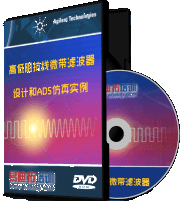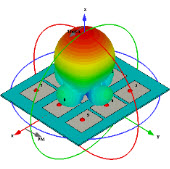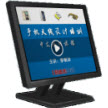CFP: ACM MONET special issue on "Ubiquitous Body Sensor Net
12-16
[We apologize in advance if you receive multiple copies of this message]
============================================================
CALL FOR PAPERS
* ACM MONET special issue on "Ubiquitous Body Sensor Networks" *
http://www.bodynets.org/docs/MONET-SI-UBSN-CFP.pdf
============================================================
Overview
Recently, there has been a lot of increasing investigation on a new type of wireless
sensor network, which is generally known as body sensor networks (BSNs). Following
the continuous advances in wireless communications technologies, there is a growing
interest in the design and development of BSNs systems for applications of improving
people’s daily life, which leads to an increasing demand on interconnecting BSNs with
other emerging wireless technologies, such as RFID technology, wireless sensor networks
(WSNs), Zigbee, Bluetooth, WiBree, video surveillance system, WPAN, WLAN, internet, and
cellular network. With BSNs being incorporated into these technologies, BSNs become
ubiquitous. The marketing opportunities for advanced consumer electronics and services
will be expanded extensively. More and more autonomous and intelligent applications
which are close to human’s life will be generated. For example, by using body sensors to
collect patient information, and by deploying diverse wireless networking systems for
enhanced diagnosis assistance and action handling, better E-healthcare management
system can be designed for providing more desirable services, which implies huge market
yet to be discovered, due to an increasing demand of E-healthcare management system
in recent years. In this special issue, we solicit research papers on body sensor hardware,
system architectures, networking & communication protocols, applications, test-bed and
prototype, biomedical sensor data processing and management. Especially, we are
interested in the following communication issues:
*Intra-BSN Communication: The terminology of “intra-BSN communication” defines the
communication directly relates to the user with the radio coverage of about 2 meters, which
consists of two categories: (1) the communication among the body sensors, which are
deployed strategically on the human body or planted inside the body, as well as attached
within in the human’s clothing; (2) the communication between the body sensors
and the portable personal server, which typically can be a cell phone, PDA or headset.
*Inter-BSN communication: The terminology of “inter-BSN communication” defines the
communication between the personal server and one or multiple access points. The access
point can be deployed as a part of infrastructure, or strategically placed in dynamic
environment for handling emergency situation. The inter-BSN communication will interconnect
BSNs with the wide range networks which are easy to be accessed in daily life.
*Beyond-BSN communication: The beyond-BSN communication is used to interconnect BSN
with outside world, which enhances the application and coverage range of body sensor system
a step further through pervasive communication technology, such as internet and cellular
networks.
The objective of this special issue is to bring together state-of-the-art research contributions,
tutorials, and position papers that address these key aspects of Ubiquitous Body Sensor Networks.
Original papers describing completed and unpublished work not currently under review by any
other journal/magazine/conference/special issue are solicited.
Topics
Topics of interest include, but are not limited to, the following scope:
- New applications of ubiquitous body-sensor networks, e.g., healthcare and consumer electronics
applications
- Remote health/fitness monitoring in ubiquitous body sensor networks, e.g., location and mobility
issues
- Ambulatory monitoring and BSN assisted rehabilitation, bio-motion, wellbeing analysis and clinical
applications
- Emerging engineering issues and wearable, implantable/ingestible sensor integration and
development platforms.
- Scalable and flexible network architectures and deployments for ubiquitous body sensor networks
- Advanced body sensor devices, e.g., novel bioelectrical, biochemical, biophysical, and mechanical
sensors
- Networking and data transmission issues for ubiquitous body sensor networks
- Integrating emerging wireless technologies with ubiquitous body sensor networks
- Integration with ambient sensors for personalized smart spaces and applications
- Link to environment sensing, smart dwellings, and home monitoring
- MAC Protocols and QoS Designing for Intra-BSN Communication
- Standards for light-weight communication protocols and integration with heterogeneous networks
- Advanced algorithms for ubiquitous body sensor networks, e.g., routing, data processing, packet
scheduling
- Power efficient issues, e.g., low power RF transceivers, energy scavenging, miniaturization, system
integration
- Signal processing, context awareness and multi-sensory fusion
- Mobile and multimedia supported ubiquitous body sensor networks
- Server side body sensor networks information processing, data mining, transient pattern recognition,
and long-term, predictive trend analysis
- Sensor data management issues for ubiquitous body sensor networks, e.g., publish-subscribe approach
- Query processing and optimization for ubiquitous body sensor networks
- Sensor data stream processing in ubiquitous body sensor networks
- Semantic Web technology enabled ubiquitous body sensor networks
- Adaptability and stability of ubiquitous body sensor networks
- Transactions and workflows in ubiquitous body sensor networks
- Information support, security, privacy, and fault tolerance issues for ubiquitous body sensor networks
Important Dates
􀁹 Manuscript submission deadline: Feb. 20, 2010
􀁹 Notification of acceptance: May 20, 2010
􀁹 Submission of final revised paper: July 20, 2010
􀁹 Publication of special issue: 3rd or 4th Quarter, 2010 (Tentative)
Submission Procedure
Authors should follow the MONET Journal manuscript format at the journal site:
http://www.springerlink.com/content/101750/ . Manuscripts
should be submitted on line through http://www.editorialmanager.com/mone/. A copy of the manuscript
should also be emailed to the following email: vasilako@ath.forthnet.gr and minchen@ece.ubc.ca. The
"Subject field" of the email must contain "MONET UBSN Paper ".
Selected papers from Bodynets-2010 (Sep. 10-12, Corfu Island, Greece) will be considered for the issue.
Guest Editors
Athanasios V. Vasilakos (University of Western Macedonia, Greece, vasilako@ath.forthnet.gr)
Victor C. M. Leung (University of British Columbia, Canada, vleung@ece.ubc.ca)
Min Chen (University of British Columbia, Canada, minchen@ece.ubc.ca)
Han-Chieh Chao (National Ilan University, Taiwan, hcc@niu.edu.tw)
Xinbing Wang (Shanghai Jiaotong University, China, theory.wang@gmail.com)
Naixue Xiong (Georgia State University, USA, nxiong@cs.gsu.edu)
============================================================
CALL FOR PAPERS
* ACM MONET special issue on "Ubiquitous Body Sensor Networks" *
http://www.bodynets.org/docs/MONET-SI-UBSN-CFP.pdf
============================================================
Overview
Recently, there has been a lot of increasing investigation on a new type of wireless
sensor network, which is generally known as body sensor networks (BSNs). Following
the continuous advances in wireless communications technologies, there is a growing
interest in the design and development of BSNs systems for applications of improving
people’s daily life, which leads to an increasing demand on interconnecting BSNs with
other emerging wireless technologies, such as RFID technology, wireless sensor networks
(WSNs), Zigbee, Bluetooth, WiBree, video surveillance system, WPAN, WLAN, internet, and
cellular network. With BSNs being incorporated into these technologies, BSNs become
ubiquitous. The marketing opportunities for advanced consumer electronics and services
will be expanded extensively. More and more autonomous and intelligent applications
which are close to human’s life will be generated. For example, by using body sensors to
collect patient information, and by deploying diverse wireless networking systems for
enhanced diagnosis assistance and action handling, better E-healthcare management
system can be designed for providing more desirable services, which implies huge market
yet to be discovered, due to an increasing demand of E-healthcare management system
in recent years. In this special issue, we solicit research papers on body sensor hardware,
system architectures, networking & communication protocols, applications, test-bed and
prototype, biomedical sensor data processing and management. Especially, we are
interested in the following communication issues:
*Intra-BSN Communication: The terminology of “intra-BSN communication” defines the
communication directly relates to the user with the radio coverage of about 2 meters, which
consists of two categories: (1) the communication among the body sensors, which are
deployed strategically on the human body or planted inside the body, as well as attached
within in the human’s clothing; (2) the communication between the body sensors
and the portable personal server, which typically can be a cell phone, PDA or headset.
*Inter-BSN communication: The terminology of “inter-BSN communication” defines the
communication between the personal server and one or multiple access points. The access
point can be deployed as a part of infrastructure, or strategically placed in dynamic
environment for handling emergency situation. The inter-BSN communication will interconnect
BSNs with the wide range networks which are easy to be accessed in daily life.
*Beyond-BSN communication: The beyond-BSN communication is used to interconnect BSN
with outside world, which enhances the application and coverage range of body sensor system
a step further through pervasive communication technology, such as internet and cellular
networks.
The objective of this special issue is to bring together state-of-the-art research contributions,
tutorials, and position papers that address these key aspects of Ubiquitous Body Sensor Networks.
Original papers describing completed and unpublished work not currently under review by any
other journal/magazine/conference/special issue are solicited.
Topics
Topics of interest include, but are not limited to, the following scope:
- New applications of ubiquitous body-sensor networks, e.g., healthcare and consumer electronics
applications
- Remote health/fitness monitoring in ubiquitous body sensor networks, e.g., location and mobility
issues
- Ambulatory monitoring and BSN assisted rehabilitation, bio-motion, wellbeing analysis and clinical
applications
- Emerging engineering issues and wearable, implantable/ingestible sensor integration and
development platforms.
- Scalable and flexible network architectures and deployments for ubiquitous body sensor networks
- Advanced body sensor devices, e.g., novel bioelectrical, biochemical, biophysical, and mechanical
sensors
- Networking and data transmission issues for ubiquitous body sensor networks
- Integrating emerging wireless technologies with ubiquitous body sensor networks
- Integration with ambient sensors for personalized smart spaces and applications
- Link to environment sensing, smart dwellings, and home monitoring
- MAC Protocols and QoS Designing for Intra-BSN Communication
- Standards for light-weight communication protocols and integration with heterogeneous networks
- Advanced algorithms for ubiquitous body sensor networks, e.g., routing, data processing, packet
scheduling
- Power efficient issues, e.g., low power RF transceivers, energy scavenging, miniaturization, system
integration
- Signal processing, context awareness and multi-sensory fusion
- Mobile and multimedia supported ubiquitous body sensor networks
- Server side body sensor networks information processing, data mining, transient pattern recognition,
and long-term, predictive trend analysis
- Sensor data management issues for ubiquitous body sensor networks, e.g., publish-subscribe approach
- Query processing and optimization for ubiquitous body sensor networks
- Sensor data stream processing in ubiquitous body sensor networks
- Semantic Web technology enabled ubiquitous body sensor networks
- Adaptability and stability of ubiquitous body sensor networks
- Transactions and workflows in ubiquitous body sensor networks
- Information support, security, privacy, and fault tolerance issues for ubiquitous body sensor networks
Important Dates
􀁹 Manuscript submission deadline: Feb. 20, 2010
􀁹 Notification of acceptance: May 20, 2010
􀁹 Submission of final revised paper: July 20, 2010
􀁹 Publication of special issue: 3rd or 4th Quarter, 2010 (Tentative)
Submission Procedure
Authors should follow the MONET Journal manuscript format at the journal site:
http://www.springerlink.com/content/101750/ . Manuscripts
should be submitted on line through http://www.editorialmanager.com/mone/. A copy of the manuscript
should also be emailed to the following email: vasilako@ath.forthnet.gr and minchen@ece.ubc.ca. The
"Subject field" of the email must contain "MONET UBSN Paper ".
Selected papers from Bodynets-2010 (Sep. 10-12, Corfu Island, Greece) will be considered for the issue.
Guest Editors
Athanasios V. Vasilakos (University of Western Macedonia, Greece, vasilako@ath.forthnet.gr)
Victor C. M. Leung (University of British Columbia, Canada, vleung@ece.ubc.ca)
Min Chen (University of British Columbia, Canada, minchen@ece.ubc.ca)
Han-Chieh Chao (National Ilan University, Taiwan, hcc@niu.edu.tw)
Xinbing Wang (Shanghai Jiaotong University, China, theory.wang@gmail.com)
Naixue Xiong (Georgia State University, USA, nxiong@cs.gsu.edu)
这位兄台ID很熟啊
最近TCCC经常看见你的CFP
像这类期刊,只有一个原型系统怎么投稿呢?
相关文章:
- CFP:ACM Q2SWinet'2007(05-08)
- CFP: Communications and Networking Simulation Symposium (CN(05-08)
- The Last Call CFP: Pervasive Multimedia Sensor Networks PMS(05-08)
- CFP: Advances in Cryptography, Security and Applications or(05-08)
- CFP:Advanced Sensor Integration Technology (ASIT 2009)(05-08)
- ACM MobiCom 2009 CFP(05-08)
射频专业培训教程推荐











